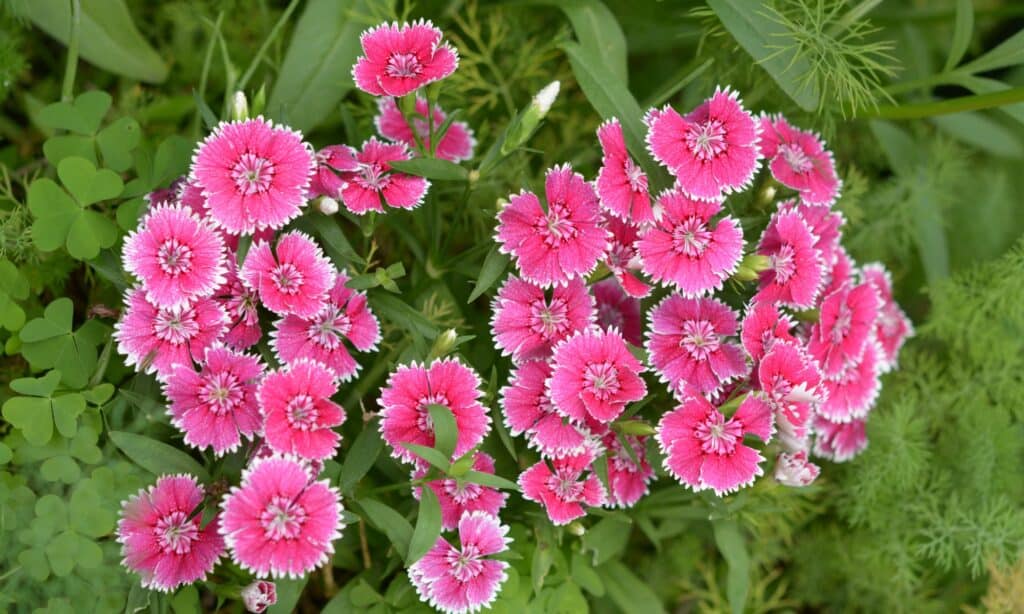Dianthuses are pretty flowers that bloom in during warmer months. They are called pinks, but this is a misleading name. The dianthus genus encompasses 340 plant species and not all of them are pink. Dianthus ranges from white to purple and every color in between! Dianthus species usually flower in mid-summer, but is it a perennial or annual?
Depending on the variety and the climate, dianthus can be grown as an annual, a perennial, or a biennial! So, how does one determine which variety of dianthus is growing in the flowerbed?
Read on to learn how to recognize the different varieties of dianthus.
Annual Dianthus
Most dianthuses are perennial plants, but because many are tender and short lived, they are grown as annuals.
Chinese pink (Dianthus chinensis) is one of the most popular and easily recognized varieties of dianthus. Though classified as a perennial, Chinese pinks are grown as annuals in warmer climates. Dianthus chinensis‘ roots will not survive extreme heat. Thanks to their long-lasting blooms, Chinese pinks are a popular choice for bouquets.

Though classified as a perennial, Chinese pinks are grown as annuals in warmer climates.
©skimin0k/Shutterstock.com
Annual plants grow roots, stems, leaves, flowers, set seed, and die all in one year! As a result, they are thirsty plants that require routine watering in the absence of rainfall and in drier climates.
Perennial Dianthus
Pink (dianthus plumarius) is the common name for most perennial dianthus.
Pinks bloom year round in warm climates and practically year round in cooler areas. They have pretty blooms with frilly-edged petals that look like they’ve been trimmed with pinking shears! SO, that’s why they’re called pinks, and not because of their color!

Pinks get their name from frilly petals that appear to have been trimmed with pinking shears.
©iStock.com/AnVyChicago
Biennial Dianthus
Sweet William is the most common variety of biennial dianthus. Biennial refers to a plant growth cycle in which it germinates, roots, and grows a stem and leaves the first year, before flowering and producing seed in year two.
Some experts believe that Sweet William was named after William Augustus, an English nobleman who fought against the Scottish Jacobite forces in the Battle of Culloden in 1746. The Scottish call Sweet William Stinking Willie!
Other experts think that the name Sweet William honors William Shakespeare, the famous English playwright. References to Sweet William date to 1596, so whatever the name’s origin it’s a well-established, well-loved species of dianthus.

Some experts think that the name Sweet William honors William Shakespeare, the famous English playwright.
©Ruth Ashmore/Shutterstock.com
What Are Dianthus?
The name dianthus is from the Greek, dios (English, heavenly), and anthos, which is Greek for flower, meaning dianthuses are heavenly flowers! They are part of the Caryophyllaceae family, a genus comprised of 340 flowering plants. It’s no wonder confusion abounds regarding dianthus’ classifications.
Though dianthus grows on most continents it is native to Europe, Asia and Africa. There’s even one species called dianthus repens that lives in the North American Arctic.
Many species of dianthus can grow in a wide variety of conditions, but the majority of dianthuses tend to prefer warm climates with plenty of rainfall. Gardeners and flower arrangers love biennial and perennial dianthus thanks to the numerous varieties available. According to the language of flowers, dianthus stands for boldness!
Differences Among Annuals, Perennials, and Biennials
What are the differences among annual, perennial, and biennial plants?
Annuals germinate, flower, set seeds, and die all in one year. Unless it’s an annual that readily self-seeds, resulting in what are commonly referred to as volunteers, annuals will not return the following year. Perennials, on the other hand will come back year after year as long as the are cared for and well-maintained. Biennials are the tricky little plants that grow their stems and leaves in their first year, but will not produce blossoms until year two.
What To Do With Dianthus After They Bloom
Deadheading wilted flowers from an annual dianthus will increase the number of blossoms and prolong its flowering cycle,. Perennial and biennial varieties benefit from this treatment too. Cutting them back to the first set of leaves after flowering to set them up for a second flush.
What Do You Do With Dianthus In Winter?
Once they have completed their growing cycle, annual dianthuses can be tossed int the compost pile.
To collect the seed, place plastic bag or an envelope over the seedhead and shake it. The small black seeds should be kept cool and dry until the following spring when they can be broadcast for summer blooms.
Cutting back a perennial dianthus to its last pair of leaves and surrounding its roots with a thick layer of organic mulch will protect it from winter’s wet and cold. Perennial dianthuses can tolerate temperatures down to minus 20 degrees, but they can’t cope with soggy roots!
In tropical and subtropical climates, it is possible to grow annual and perennial dianthus year-round.
Do Dianthus Do Well In Pots?
All types of dianthuses do well in pots and containers and can brighten up a boring deck or patio. For the best results use good quality potting soil, watering them only when the soil feels dry. Place pots in Andrea tat gets bright, indirect sun, as midday sun that can burn the plant’s tender foliage.
In winter, lifting a potted dianthus off of the ground creates good drainage from winter rain, which keeps the roots from rotting. Elevating the pot by placing bricks strategically underneath is all that is needed.
Dianthus is a huge genus that contains biennial and perennial species, and depending on where it is grown, may have characteristics similar to an annual.
Up Next:
The photo featured at the top of this post is © joloei/Shutterstock.com
Sources
- usda, Available here: https://planthardiness.ars.usda.gov/
- etymonline, Available here: https://www.etymonline.com/word/dianthus
- gardenersworld, Available here: https://www.gardenersworld.com/how-to/grow-plants/dianthus-grow-guide/
- kewgardens, Available here: https://powo.science.kew.org/taxon/urn:lsid:ipni.org:names:6245-1
Thank you for reading! Have some feedback for us? Contact the AZ Animals editorial team.






